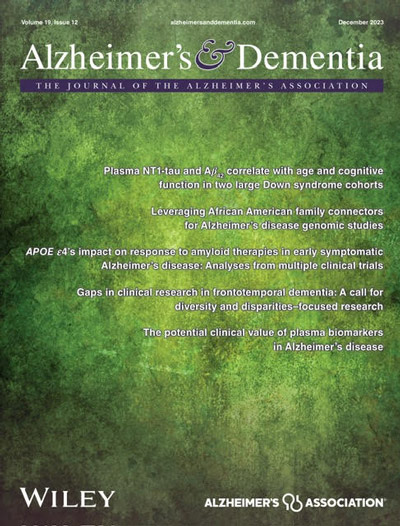简短嗅觉和认知评估与神经影像生物标志物在预测 MCSA 队列中认知能力下降和痴呆症方面的比较
IF 13
1区 医学
Q1 CLINICAL NEUROLOGY
引用次数: 0
摘要
简介我们评估了梅奥诊所老龄化研究中受损的气味识别能力和整体认知能力,将其作为神经影像生物标志物的简单、经济有效的替代品,用于预测认知能力下降和痴呆症。结果102名参与者出现认知能力下降,34名参与者出现痴呆。在生存分析中,PiB PET 对认知能力下降有很强的预测能力。BSIT受损、BIMCT受损、MRI和FDG测量也是重要的预测因素。人口统计学+BSIT+BIMCT组合显示出很强的预测效用(C指数0.81),与人口统计学+PiB PET(C指数0.80)相似。在以人群为基础的梅奥诊所老龄化研究(Mayo Clinic Study of Aging)的 647 名参与者中,几种临床标记物和生物标记物均可预测平均 8 年随访期间的认知能力下降或痴呆。将年龄、性别和教育程度等人口统计学变量与简短气味识别测试(BSIT)和全局认知测试(Blessed Information Memory Concentration Test)相结合,对认知能力下降有很强的预测作用(C-index 0.81),与人口统计学变量与匹兹堡化合物 B 淀粉样蛋白成像相结合的预测作用(C-index 0.80)相似。需要考虑将简短的气味识别测试与简短的认知测试结合起来,作为对认知功能下降和痴呆症高危人群进行临床评估的一种简单、经济有效的选择,同时也是一种潜在的工具,可用于识别可能从疾病改变治疗中获益的人群,以及筛选预防试验的参与者。本文章由计算机程序翻译,如有差异,请以英文原文为准。
Comparison of brief olfactory and cognitive assessments to neuroimaging biomarkers in the prediction of cognitive decline and dementia in the MCSA cohort
INTRODUCTIONWe evaluated impaired odor identification and global cognition as simple, cost‐effective alternatives to neuroimaging biomarkers to predict cognitive decline and dementia in the Mayo Clinic Study of Aging.METHODSSix hundred forty‐seven participants (mean 8.1, standard deviation 3.4 years’ follow‐up) had the following baseline procedures: modified Blessed Information Memory Concentration Test (BIMCT), 12‐item Brief Smell Identification Test (BSIT), structural brain magnetic resonance imaging (MRI), and positron emission tomography (PET) imaging with 11C‐Pittsburgh compound B (11C‐PiB) and fluorodeoxyglucose (FDG; subset).RESULTSCognitive decline developed in 102 participants and dementia in 34 participants. In survival analyses, PiB PET showed robust prediction for cognitive decline. Impaired BSIT, impaired BIMCT, MRI, and FDG measures were also significant predictors. The combination of demographics + BSIT + BIMCT showed strong predictive utility (C‐index 0.81), similar to demographics + PiB PET (C‐index 0.80). Similar but stronger results were obtained for prediction of dementia.DISCUSSIONImpairment in both odor identification test and global cognition was comparable to PiB PET for predicting cognitive decline and dementia.Highlights In 647 participants in the population‐based Mayo Clinic Study of Aging, several clinical markers and biomarkers each predicted cognitive decline or dementia during an average 8 years of follow‐up. The combination of the demographic variables of age, sex, and education with a brief odor identification test (BSIT) and a global cognitive test (Blessed Information Memory Concentration Test) showed strong predictive utility (C‐index 0.81) for cognitive decline that was similar to the demographic variables combined with Pittsburgh Compound B amyloid imaging (C‐index 0.80). Combining a brief odor identification test with a brief cognitive test needs consideration as a simple, cost‐effective option in the clinical assessment of individuals at risk of cognitive decline and dementia, as well as a potential tool to identify individuals who may benefit from disease‐modifying treatments and to screen participants for prevention trials.
求助全文
通过发布文献求助,成功后即可免费获取论文全文。
去求助
来源期刊

Alzheimer's & Dementia
医学-临床神经学
CiteScore
14.50
自引率
5.00%
发文量
299
审稿时长
3 months
期刊介绍:
Alzheimer's & Dementia is a peer-reviewed journal that aims to bridge knowledge gaps in dementia research by covering the entire spectrum, from basic science to clinical trials to social and behavioral investigations. It provides a platform for rapid communication of new findings and ideas, optimal translation of research into practical applications, increasing knowledge across diverse disciplines for early detection, diagnosis, and intervention, and identifying promising new research directions. In July 2008, Alzheimer's & Dementia was accepted for indexing by MEDLINE, recognizing its scientific merit and contribution to Alzheimer's research.
 求助内容:
求助内容: 应助结果提醒方式:
应助结果提醒方式:


